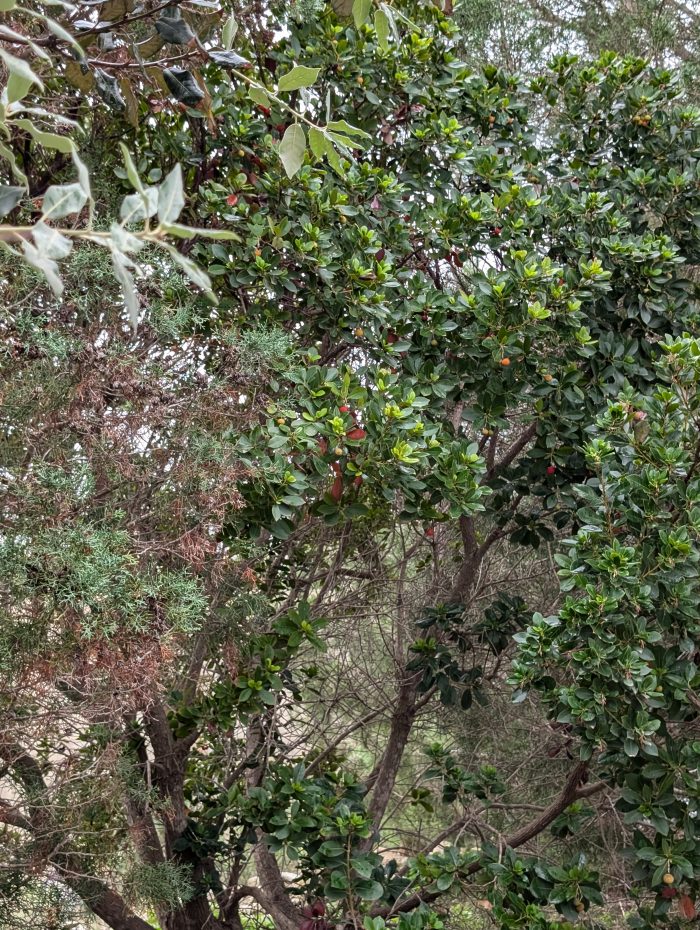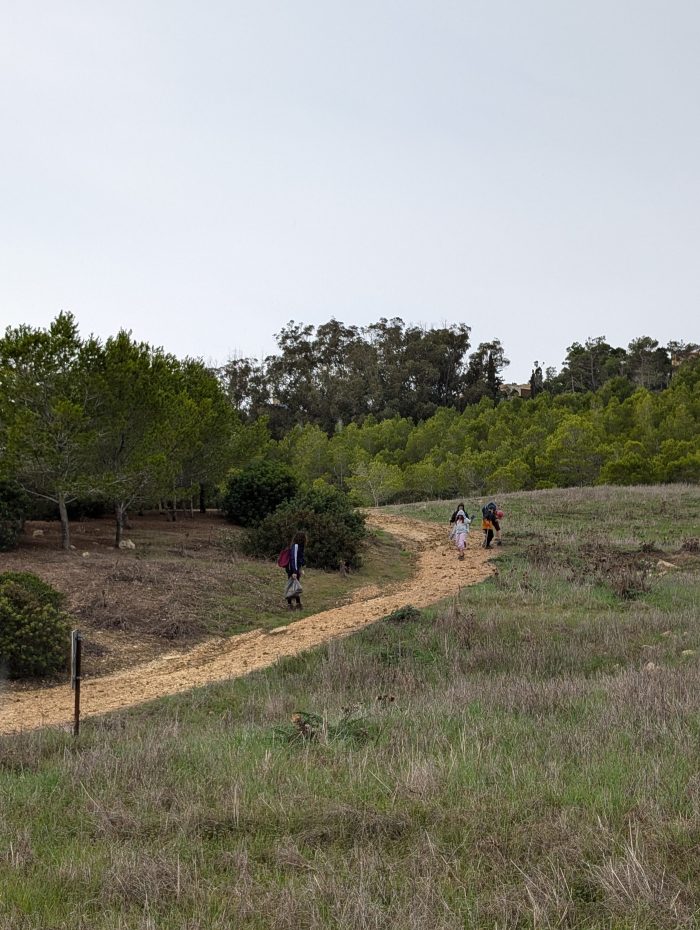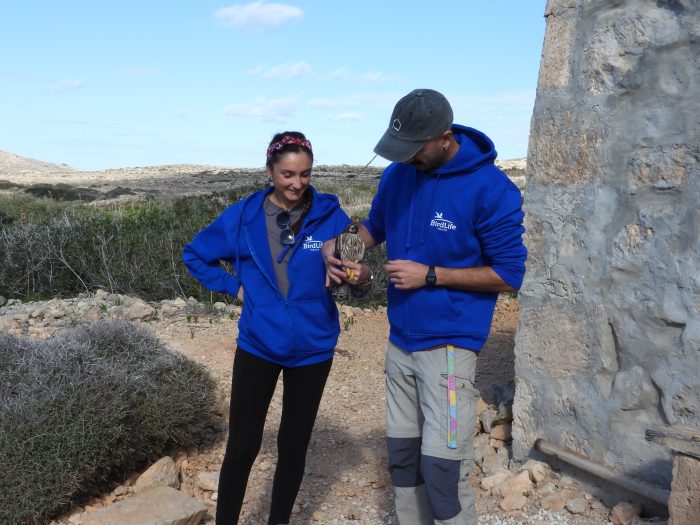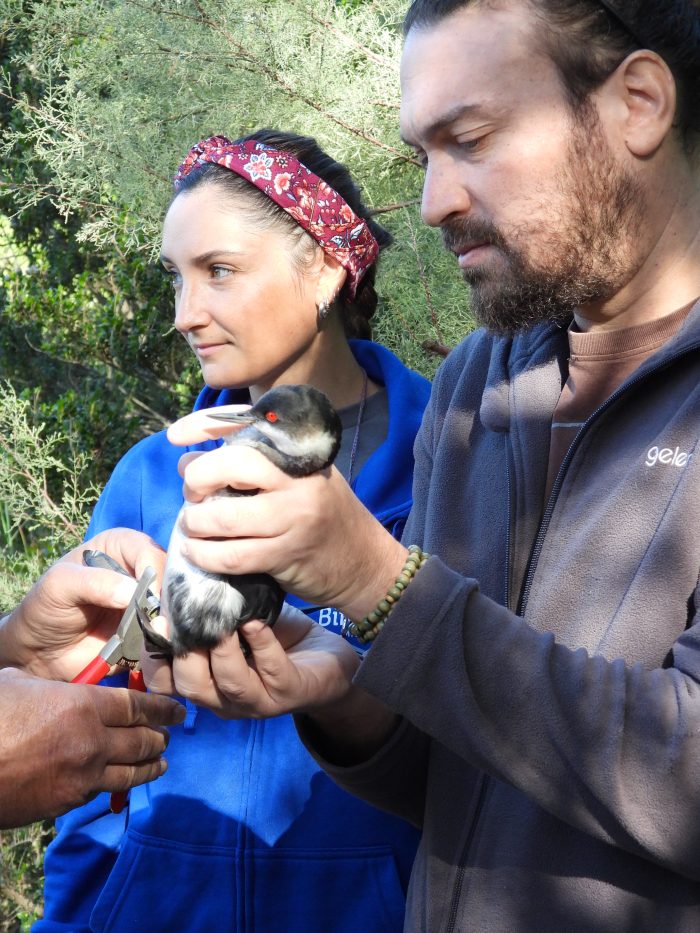On the frontlines is our monthly newsletter section covering the activities of BirdLife Malta’s conservation, policy and nature reserve (Salina, Simar, Għadira and Foresta 2000) teams, together with an update about rare and scarce bird species observed.

Trapper charged for use of mist net
BirdLife Malta’s Conservation team reported a man to the police for using an illegal trapping method in Żejtun. The man had spread a mist net across his private land. Upon arrival, the police apprehended the man on site and confiscated the long mist net along with three electronic caller devices, which are commonly used to lure birds into traps. The case has been documented and will be taken to court in due course.
Trapper charged for possession of protected species
BirdLife Malta’s Conservation team identified and reported another illegal activity in Marsaskala. A trapper operating on a registered site was caught accessing the boot of his car to retrieve finches he had caught. Upon being alerted, the police arrived swiftly, apprehended the trapper on site, and seized the illegally captured birds. The trapper’s special licence was immediately revoked, and the case will result in court charges.
Confiscated White Stork to be released in Sicily
Earlier this spring, a White Stork was confiscated by police from a private residence in Birżebbuġa and handed over to BirdLife Malta for rehabilitation. The bird had been illegally held and required careful monitoring and care to ensure a successful recovery. After several months of rehabilitation, the stork will soon be released in Sicily, where it can return to its natural habitat. On 20th November 2024, the court sentenced the offender to a €1,500 fine and imposed a three-year suspension of their hunting licence.
Latest bird releases
November has proven to be a busy month, not only due to the peak migration season but also because of the ongoing recovery and release of birds affected by illegal hunting and other incidents. A Common Kestrel, which had its migration brutally interrupted by a poacher, was successfully rehabilitated and released on the island of Comino. With its injuries treated, the kestrel is expected to continue its journey southward towards Africa.
Another success story involved a juvenile Night Heron and a Black-necked Grebe. The night heron had suffered a fractured wing, while the grebe was found stranded in a Gozo village, severely dehydrated. Aquatic birds like grebes are particularly vulnerable when on land, as their bodies are not adapted for terrestrial movement, and dehydration can worsen their condition rapidly. Thanks to immediate intervention and expert care, the grebe was stabilised overnight, given a waterproofing test, and successfully released at Għadira Nature Reserve. Both the grebe and the night heron were later observed thriving in the wild by birdwatchers.
Additionally, BirdLife Malta attended to several gulls this month, with a Lesser Black-backed Gull and two Yellow-legged Gulls being treated for severe dehydration and infection. Following their recovery, all three birds were successfully released. A Barn Swallow also received specialised care after colliding with a window, which had caused damage to its shoulder. The swallow underwent weeks of physiotherapy and hand-feeding to rebuild its strength. Once it regained its ability to fly, it was successfully returned to the wild.

Salina Nature Reserve
Sightings
Wintering gulls of various species, including the first Little Gull and Kittiwake for this season, were the ever-present backdrop to less numerous birds in the reserve, such as Black-necked Grebes, Shelducks, Kingfishers, Common Sandpipers, Little Egrets, and the infrequent Sandwich Tern. Without a shadow of a doubt, the highlight of the month was a Thrush Nightingale that was ringed in the wetland. The last record of this species in Malta dates back to 1988!
Works and visits
Our efforts to attract groups of visitors from Local Councils resulted in two more groups from Swieqi and San Ġwann. These groups, consisting of senior citizens, had a great time and were impressed with the reserve and the experience it offered. They learned about BirdLife Malta’s work to restore the wetland while enjoying some refreshments. They also visited the Salt Museum and learned about the history of salt production in Malta, with some time allocated for birdwatching. Salina also hosted the BirdLife Malta Annual General Meeting.
Translations of the twelve information displays in the main hall were produced in English, French, and Spanish. These are now accessible to visitors via a QR code, where they can learn about the different habitats at Salina and the research being done through colour-ringed gulls and bird ringing.
The process of seeking authorisations and permits for a cafeteria on the first floor of the Visitors’ Centre has begun. Although these are very early steps, we are hopeful this addition will give the reserve a new dimension and attract more visitors.
Għadira Nature Reserve
Sightings
As the southbound migration came to a close, the reserve saw a gradual shift towards wintering birds. Among the regulars were three Black-necked Grebes, a Little Grebe, a Coot, and a couple of Common Teals, which became a familiar sight throughout the month. Moorhens were particularly abundant, with more than 30 individuals spotted almost daily, while Reed Buntings appeared in greater numbers this year, with small flocks frequenting the area. Kingfishers were also a constant presence, their vibrant colours adding to the landscape, while the occasional call of a Wryneck added a touch of mystery to the reserve. In addition, a Little Bunting was ringed, and a Common Buzzard made a rare appearance. Other notable sightings included occasional records of Marsh Harriers, Common Snipes, and Jack Snipes, as well as a small group of wild Mallards and a Shoveler. A migratory flock of seven Cattle Egrets also passed through.




Works
The reserve was opened again to the public once the major works on the birdwatching hide were completed. Landscaping works included the planting of Lentisk and Chaste trees, the laying of mulch and branches, and the installation and repair of wooden handrails along the public path where necessary.
Simar Nature Reserve
Sightings
As the days grow colder and daylight shortens, nature at Simar continues its quiet adaptation to the seasonal changes. The stands of reed have slowly transformed into golden-brown reedbeds, while the tamarisks lining the island fringes shed their leaves, exposing their weathered branches. Rising water levels have crept onto the islands, submerging low-lying vegetation and creating new feeding areas for many water birds.
These changes have drawn in a wide variety of waterfowl, some of which have stayed for several days or even weeks. The wetland’s diverse feeding areas have proven essential, providing small aquatic invertebrates, fish, new vegetative shoots, and halophytic plant seeds, all of which have become key food sources for the birds. Among the ducks present throughout the month were Northern Pintails, Northern Shovelers, Mallards, and several Eurasian Teals. Additionally, several Common Coots have settled in for the winter. Water Rails and Moorhens have been particularly abundant, along with a few Black-necked Grebes and Little Grebes, though these remain mostly secretive. Common Kingfishers continue to grace the reserve, while Great Cormorants occasionally visit. A Grey Heron can often be seen roosting for the night in the reserve.
A rare visitor made a brief appearance: a male Penduline Tit. Another notable sighting was of the Moustached Warbler, one of Europe’s most elusive birds, which was present in unprecedented numbers. Up to four individuals were often spotted, offering good views of this typically secretive species that is usually found deep in dense vegetation close to water. The reserve also hosted large numbers of Common Chiffchaffs and Robins, along with Reed Buntings, Common Stonechats, and Blackcaps, all feeding in the wetland.
A truly unexpected visitor to the reserve was a Short-toed Snake Eagle, which flew over one morning before spending some time soaring over the nearby hills.



Foresta 2000
Sightings
November brought the much-awaited rains, breathing life into Foresta 2000. The greenery flourished rapidly, transforming the landscape into lush green hills. Rock pools began to fill with water, creating new habitats and serving as a vital water source for many species.
As usual, Foresta 2000 proved to be a welcoming spot for winter visitors and migrants. European Starlings, Black Redstarts, and Stonechats seemed particularly at home in the forest. Blackcaps, Chaffinches, Wood Warblers, and Chiffchaffs could also be seen flitting through the trees, while Robins were abundant, especially in the pine canopies near the main gate.
Although fewer in number, Barn Swallows were still gracefully soaring above, and Common Kestrels were spotted quite frequently throughout the month, hovering in the skies in search of prey. Meanwhile, the cliffs and the area around the old hotel echoed with the melodious song of Blue Rock Thrushes, a year-round resident of Foresta 2000.
Reptiles remained active despite the cooling weather, with Western Whip Snakes often spotted basking or moving through the undergrowth.
Insects continued to add vibrant life to the forest. Dragonflies such as the Blue Emperor and Scarlet Darter were abundant, with their colourful males and duller females darting about. Butterflies like the Painted Lady and Small White Butterfly remained present. Visitors might have even witnessed dragonflies attempting to catch butterflies in a fascinating display of nature’s dynamic interactions.






Works
Regular clean-ups and area monitoring continued with the support of volunteers. A special visit took place from Graduated Nature Guardians from past years. Together with their parents, despite a bit of rain, the group enjoyed discovering new plant species, observing birds, and spotting chameleons—a memorable experience for all involved.
Make sure to visit Foresta 2000 soon to experience the magic of a Maltese winter!


In November, our graduated Nature Guardians had the opportunity to spend their weekends exploring the beauty of Simar, Foresta 2000, and Salina. These young nature enthusiasts had a blast preparing nature-inspired Christmas decorations, letting their creativity shine while connecting with the natural world. Alongside the festive fun, they delved into the unique landscapes of each reserve, discovering fascinating wildlife and learning more about the habitats they’ve grown to cherish. It was a perfect mix of adventure, creativity, and teamwork! The Nature Guardians programme, which offers children hands-on experience with wildlife and conservation, continues to inspire even after its official sessions conclude. These activities provided a wonderful opportunity to celebrate their achievements, deepen their friendships, and enjoy the spirit of teamwork while contributing to a festive cause. If you want to join our team of 7-11-year-old nature lovers, fill out the application form to secure your spot for the spring 2025 course!
Notice for All Visitors As winter approaches and the days grow shorter, we are transitioning to our annual winter schedule. We want to remind everyone that our nature reserves, Simar and Għadira, will now be closing at sunset. With the recent time change, it gets darker earlier, and visibility in the reserves becomes limited after sundown. Please plan your visits accordingly so you can enjoy the beauty of nature in full daylight. We look forward to welcoming you and appreciate your help in keeping the reserves safe and enjoyable for all. See you on the trails!

Recommendations on the Coordinated Assessment for the Proposed Marsalforn Coastal Defence system
In response to the Coordinated Assessment for the Marsalforn Coastal Defence System, we provided our recommendations, emphasising on ecological protection and community benefits. Our proposals included supporting fishermen through reserved berths, waste receptacles, and storage solutions. We advocated for eco-sensitive lighting to reduce impacts on marine fauna and stressed the need to address sedimentation risks affecting Posidonia oceanica. Key measures included seagrass restoration, ecological mooring to prevent damage, and a comprehensive bay clean-up. Additionally, we highlighted the importance of sediment monitoring and upstream valley management to mitigate flooding and enhance biodiversity. These steps aim to balance environmental conservation with the needs of residents, tourists, and local industries.
Read our feedback here.
Recommendations for the PTM Waste Management Facility in Ħal Far
BirdLife Malta provided detailed recommendations for the EIA Terms of Reference for the PTM Waste Management Facility in Ħal Far. We highlighted the need to conduct avifauna assessments given the presence of shearwater colonies a few metres away from the site. Ħal Far is a seabird grounding hotspot hence we recommended ecologically sensitive lighting to prevent any further light pollution. We stressed the need for vibration and geotechnical studies, especially given the site’s proximity to Għar Ħasan. Traffic impact and noise pollution assessments were also recommended to minimise harm to the surrounding sensitive areas and species. Finally, we called for emissions studies and a robust monitoring framework to ensure effective mitigation measures throughout construction and operation phases.
Read our recommendations here.
Comments on Environmental Impact Assessment for St. Albert College Construction in Ħal Għaxaq
As part of the public consultation for the Environmental Impact Assessment (EIA) for the proposed St. Albert College in Ħal Għaxaq, we raised our concern for the unjustified loss of 26,495 m² of agricultural land and 51 protected trees. We highlighted inconsistencies in the EIA regarding the quality of the agricultural land present on site and criticised the non-transparent site selection process. In 2000, the former Planning Authority/Malta Environment and Planning Authority (MEPA) conducted a site selection exercise, identifying the Għaxaq site as the preferred location for relocating St. Albert the Great College from a list of 12 potential sites. This site selection exercise still remains a mystery and the EIA fails once again to convincingly present any credible effort by the applicant at finding any alternatives to the uptake of this amount of undeveloped land. Additionally, we noted conflicts with local policies protecting agricultural land and ODZ areas. We urged the developers for reconsideration of alternative sites or configurations to avoid using undeveloped land and advocated for solutions that preserve open spaces and food security for future generations.
Read our feedback here.

Feedback on Villa Rosa Local Plan Review
Once again the Planning Authority is proposing amendments to local plans to accommodate development plans, this time for the Villa Rosa site. As part of the public consultation for this local plan review, we expressed concerns on the Planning Authority’s lack of transparency on the rationale for this amendment. The proposed review states that the sub-zones designated in the original 2006 Local Plan area will be reconfigured. However, the map provided only outlines the boundary of the Villa Rosa area without detailing the proposed reconfiguration. Misleading statements on site boundaries and unclear objectives, such as “higher quality hotels,” raise further issues and hinders public understanding. We highlighted environmental risks from intensified development and urged safeguards for sensitive areas. Additionally, we criticised the apparent intent to accommodate developers without adequate scrutiny. Finally, we called for clarity, detailed plans, and meaningful public consultation before advancing with this review.
Read our feedback here.
BirdLife Malta Feedback on Majjistral Park Regulation Amendments
We submitted our feedback on proposed amendments to the Majjistral Nature and History Park Regulations. We recommended that the Board of the park should retain an active role in management planning, ensuring its expertise informs robust conservation efforts. Additionally, we emphasised that issuing a management plan should remain compulsory, reflecting the park’s protected status. The amendments are proposing the omission of the list which specified who will act as ‘management organisations’ of the park. This creates uncertainty on which organisations will be responsible for the management of the park. In response we propose that a limit on the number of managing organisation should be set and a stricter eligibility criteria to ensure expertise in environmental conservation should be established. We also urged public consultation in the selection process to maintain transparency and community trust. These steps are essential to safeguard the park’s ecological and cultural heritage.
Read our feedback here.


A glimpse of a rare visitor from the north
Recently a Black-legged Kittiwake, in Maltese Gawwija tal-Ingilterra, made a short appearance at the Salina Nature Reserve. A dainty gull of northern oceans, Kittiwakes are true pelagic seabirds, spending virtually their entire lives on the open ocean and only touching land during the nesting season. This occurs between February and August when they make their nest in large colonies on cliffs of the North Atlantic, North Pacific, and Arctic.
Breeding adults have a white head and body with a light grey mantle and wings with a black tip, the beak is yellow and as the name suggests the legs, which are very short, are black. Kittiwakes take three years to attain full adult plumage. The bird present at Salina was a 1st winter one having a white body with light grey wings and upperparts; some black markings on the head and a black shawl like pattern on the neck. A distinguishing black V pattern on the upper wing is also present.
In the past the status of the Kittiwake was considered as a vagrant in Malta, with only eight known records between 1843 and 1980. In recent years an increase in records has been noted and its status is now considered as a rare species with only two to five recorded annually. Mostly records are between November and March which marks the peak season for gulls. Most sightings are of birds out at sea, but occasionally individuals are also observed in BirdLife Malta reserves such as Salina.



Credits
Words: Charles Coleiro, David Attard, Isabel Celeste, Justine Borg, Khouloud Belhadj, Manuel Mallia, Marcella Giornetti, Mario V Gauci, Vera Tokmakova,
Photographs: Bernadette Chircop, Mario V Gauci, Google Earth,Charles Coleiro, David Attard, Manuel Mallia, Vera Tokmakova
Editing: Khouloud Belhadj




